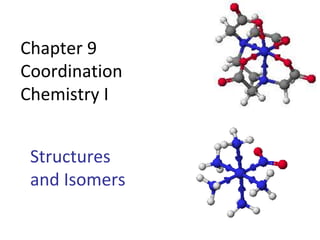fdocuments.in_chapter-9-coordinatin-chemistry-i.ppt
•Transferir como PPT, PDF•
0 gostou•2 visualizações
Ybb
Denunciar
Compartilhar
Denunciar
Compartilhar

Recomendados
Recomendados
metais transiçãonew-chm-152-unit-10-coordinaton-chemistry-power-pointssp13-140218221853-phpap...

new-chm-152-unit-10-coordinaton-chemistry-power-pointssp13-140218221853-phpap...FilipeJooPintoDaCost
Mais conteúdo relacionado
Semelhante a fdocuments.in_chapter-9-coordinatin-chemistry-i.ppt
metais transiçãonew-chm-152-unit-10-coordinaton-chemistry-power-pointssp13-140218221853-phpap...

new-chm-152-unit-10-coordinaton-chemistry-power-pointssp13-140218221853-phpap...FilipeJooPintoDaCost
Semelhante a fdocuments.in_chapter-9-coordinatin-chemistry-i.ppt (20)
djtkffpes9gtl4fkqdkh-signature-016162306cab773303228479b063befdf29baf20ea52f9...

djtkffpes9gtl4fkqdkh-signature-016162306cab773303228479b063befdf29baf20ea52f9...
Coordination compounds (12th Maharashtra state board)

Coordination compounds (12th Maharashtra state board)
Coordination chemistry/Descriptive Chemistry /Transition Metals

Coordination chemistry/Descriptive Chemistry /Transition Metals
new-chm-152-unit-10-coordinaton-chemistry-power-pointssp13-140218221853-phpap...

new-chm-152-unit-10-coordinaton-chemistry-power-pointssp13-140218221853-phpap...
Último
Último (20)
B.tech Civil Engineering Major Project by Deepak Kumar ppt.pdf

B.tech Civil Engineering Major Project by Deepak Kumar ppt.pdf
Simple, 3-Step Strategy to Improve Your Executive Presence (Even if You Don't...

Simple, 3-Step Strategy to Improve Your Executive Presence (Even if You Don't...
Top profile Call Girls In Gangtok [ 7014168258 ] Call Me For Genuine Models W...![Top profile Call Girls In Gangtok [ 7014168258 ] Call Me For Genuine Models W...](data:image/gif;base64,R0lGODlhAQABAIAAAAAAAP///yH5BAEAAAAALAAAAAABAAEAAAIBRAA7)
![Top profile Call Girls In Gangtok [ 7014168258 ] Call Me For Genuine Models W...](data:image/gif;base64,R0lGODlhAQABAIAAAAAAAP///yH5BAEAAAAALAAAAAABAAEAAAIBRAA7)
Top profile Call Girls In Gangtok [ 7014168258 ] Call Me For Genuine Models W...
Top profile Call Girls In Shillong [ 7014168258 ] Call Me For Genuine Models ...![Top profile Call Girls In Shillong [ 7014168258 ] Call Me For Genuine Models ...](data:image/gif;base64,R0lGODlhAQABAIAAAAAAAP///yH5BAEAAAAALAAAAAABAAEAAAIBRAA7)
![Top profile Call Girls In Shillong [ 7014168258 ] Call Me For Genuine Models ...](data:image/gif;base64,R0lGODlhAQABAIAAAAAAAP///yH5BAEAAAAALAAAAAABAAEAAAIBRAA7)
Top profile Call Girls In Shillong [ 7014168258 ] Call Me For Genuine Models ...
Novo Nordisk Kalundborg. We are expanding our manufacturing hub in Kalundborg...

Novo Nordisk Kalundborg. We are expanding our manufacturing hub in Kalundborg...
Top profile Call Girls In Hubli [ 7014168258 ] Call Me For Genuine Models We ...![Top profile Call Girls In Hubli [ 7014168258 ] Call Me For Genuine Models We ...](data:image/gif;base64,R0lGODlhAQABAIAAAAAAAP///yH5BAEAAAAALAAAAAABAAEAAAIBRAA7)
![Top profile Call Girls In Hubli [ 7014168258 ] Call Me For Genuine Models We ...](data:image/gif;base64,R0lGODlhAQABAIAAAAAAAP///yH5BAEAAAAALAAAAAABAAEAAAIBRAA7)
Top profile Call Girls In Hubli [ 7014168258 ] Call Me For Genuine Models We ...
Top profile Call Girls In Agartala [ 7014168258 ] Call Me For Genuine Models ...![Top profile Call Girls In Agartala [ 7014168258 ] Call Me For Genuine Models ...](data:image/gif;base64,R0lGODlhAQABAIAAAAAAAP///yH5BAEAAAAALAAAAAABAAEAAAIBRAA7)
![Top profile Call Girls In Agartala [ 7014168258 ] Call Me For Genuine Models ...](data:image/gif;base64,R0lGODlhAQABAIAAAAAAAP///yH5BAEAAAAALAAAAAABAAEAAAIBRAA7)
Top profile Call Girls In Agartala [ 7014168258 ] Call Me For Genuine Models ...
Top profile Call Girls In Raipur [ 7014168258 ] Call Me For Genuine Models We...![Top profile Call Girls In Raipur [ 7014168258 ] Call Me For Genuine Models We...](data:image/gif;base64,R0lGODlhAQABAIAAAAAAAP///yH5BAEAAAAALAAAAAABAAEAAAIBRAA7)
![Top profile Call Girls In Raipur [ 7014168258 ] Call Me For Genuine Models We...](data:image/gif;base64,R0lGODlhAQABAIAAAAAAAP///yH5BAEAAAAALAAAAAABAAEAAAIBRAA7)
Top profile Call Girls In Raipur [ 7014168258 ] Call Me For Genuine Models We...
Miletti Gabriela_Vision Plan for artist Jahzel.pdf

Miletti Gabriela_Vision Plan for artist Jahzel.pdf
fdocuments.in_chapter-9-coordinatin-chemistry-i.ppt
- 2. Coordination compounds • Central metal, neutral or cation • Ligand: neutral molecule or anion • Ions for charge balance (if necessary) • Coordination number = number of ligand attachments (commonly 4, 6, 5) • Geometric and optical isomers possible • Kf values: usually very large, >1010
- 3. Naming Coordination Compounds • Cation + anion • Ligands + metal in coordination compound • Charge indicated by Roman numerals in parentheses • If complex ion carries a negative charge, add -ate to the name of the metal • Ligands are named in alphabetical order • Prefixes indicate the number of ligands
- 4. Naming Ligands • Neutral - aqua, ammine, carbonyl • Anion - chloro, nitro, sulfato • Cations are not common • Chelating - multidentate ethylenediamine EDTA acac • Prefix if ligand is “complex” (neutral or name contains a prefix) 2 (bis), 3 (tris), 4 (tetrakis)
- 8. Some examples... • Pt(NH3)4 2+ • [Co(NH3)4(H2O)2]Cl2 • Ligands shown in Tables in Chapter 9 • Bridging ligands - μ • Naming rules in Chapter 9 • Exercises 9-1 and 9-2
- 9. Common Structures • CN 1, 2, 3 - follow VSEPR Bulky ligands, filled d-orbitals Ag(I), Cu(I), Au(I) • CN 4 - Tetrahedral or Square Planar d10 - tetrahedral; d8 - square planar • CN 5 - trigonal bipyramid or square pyramid Similar energy • CN 6 - octahedral + distorted octahedron • CN 7, 8, ... more unusual, but known
- 10. Coordination Compound Isomers • Stereoisomers geometric and optical isomers • Structural hydrate, solvent, ionization, linkage isomers
- 11. Geometric Isomers • CN 4 and 6 most common • cis, trans • fac, mer • Isomer designations for compounds containing chelating ligands can get complicated (see textbook), we will not use
- 12. Geometric + Optical Isomers • Octahedral geometry (consider monodentate ligands only): trans-pair method • Mabcdef: Identify all trans pairs, then identify optically active isomers (ab)(cd)(ef), (ab)(ce)(df), (ab)(cf)(de), ...... • Try Ma2b2cd • Diastereomer + mirror image = pair of enantiomers • Bidentate ligands? Use capital letters or “manual” method to identify geometric isomers • M(AA)(BB)c2 • How many isomers? How many chiral isomers?
- 14. 14
- 15. Structural isomers • What is inside the coordination sphere? • CrCl3 .6H2O has three hydrate isomers: non, mono, and di-hydrate • Coordination isomers differ in what is inside the coordination sphere of each metal [Pt(NH3)4][PtCl4] vs. [PtCl(NH3)3][Pt(NH3)Cl3] • Ionization isomers give different number of ions in solution or different ions in solution [Co(NH3)4(NO2)Cl]Cl [Co(NH3)4Cl2]NO2
- 16. Linkage • Atom bonding to metal changes • NO2 - • M-NO2 - nitro M-ONO - nitrito • Can be converted by gentle heating • SCN- bonds through S or N • DMSO - S or O
- 18. 18
- 20. 20 Magnetic Susceptibility g = constant S = spin quantum number (multiplicity) = 2(total spin) + 1 L = sum of the highest possible ml values following Hund’s rule
- 23. 23
- 24. 24
- 25. 25
- 26. 26
- 27. 27